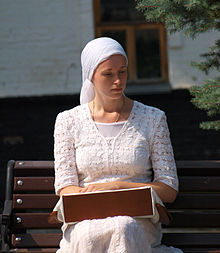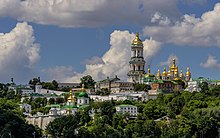|
Kyiv Pechersk Lavra
Kyiv-Pechersk Lavra[1][2] or Kyievo-Pecherska Lavra (Ukrainian: Києво-Печерська лавра), also known as the Kyiv Monastery of the Caves, is a historic Eastern Orthodox Christian monastery which gave its name to one of the city districts where it is located in Kyiv. Since its foundation as the cave monastery in 1051, the Lavra has been a preeminent center of Eastern Orthodox Christianity in Eastern Europe.[3] Etymology and other names In Ukrainian, the word pechera (in Ukrainian Cyrillic печера) means cave which itself came from Proto-Slavic *реktera that means cave as well. The word lavra is used to describe high-ranking male monasteries for monks of the Eastern Orthodox Church. Therefore, the name of the monastery is also translated as Kyiv Cave Monastery, Kyiv Caves Monastery or the Kyiv Monastery of the Caves (на печерах).[citation needed] HistoryFoundation and early historyThe Primary Chronicle contains contradictory information as to when the monastery was founded: in 1051, or in 1074.[5] Anthony, a Christian monk from Esphigmenon monastery on Mount Athos, originally from Liubech of the Principality of Chernigov, returned to Rus' and settled in Kyiv as a missionary of monastic tradition to Kyivan Rus'. He chose a cave at the Berestov Mount that overlooked the Dnieper River and a community of disciples soon grew. Prince Iziaslav I of Kyiv ceded the whole mount to the Anthonite monks who founded a monastery built by architects from Constantinople.[citation needed] At the Kyiv Pechersk Lavra were buried some high-importance personalities from the period when Kyiv was a part of the Grand Duchy of Lithuania: Prince of Kyiv Vladimir Olgerdovich and his son Aleksandr Olelka, the Lithuanian and Ruthenian Grand Duke Švitrigaila, Feodor Ostrogski, Uliana Olshanska (a second wife of the Lithuanian Grand Duke Vytautas the Great), and the Lithuanian Grand Hetman Konstanty Ostrogski, known for commanding the Grand Ducal Lithuanian Army in the victorious Battle of Orsha (1514) versus the Grand Principality of Moscow Army.[6] Modern historyTogether with the Saint Sophia Cathedral, the Kyiv Pechersk Lavra has been inscribed as a UNESCO World Heritage Site since 1990.[7][nb 1] The monastery complex is considered a separate national historic-cultural preserve (sanctuary), the national status to which was granted on 13 March 1996.[9] The Lavra is not only located in another part of the city, but is part of a different national sanctuary than Saint Sophia Cathedral. While being a cultural attraction, the monastery is once again active, with over 100 monks in residence.[citation needed] It was named one of the Seven Wonders of Ukraine on 21 August 2007.[citation needed] Until the end of 2022, jurisdiction over the site had been divided between the state museum, National Kyiv-Pechersk Historic-Cultural Preserve,[10] and the Ukrainian Orthodox Church (Moscow Patriarchate) (UOC-MP) as the site of the chief monastery of that Church and the residence of its leader, Onufrius, Metropolitan of Kyiv and All Ukraine.[11][12] In January 2023, the Ukrainian government terminated the UOC-MP's lease of the Dormition Cathedral and the Refectory Church (also known as the Trapezna Church), returning those properties to direct state control.[13][14] It also announced that the Orthodox Church of Ukraine (OCU) had been granted permission to celebrate a Christmas service in the Dormition Cathedral, on 7 January 2023, Orthodox Christmas by the Old Calendar,[14] a service which was celebrated by Metropolitan Epiphanius at 9am that day.[15] On 10 March 2023, the National Kyiv-Pechersk Historic-Cultural Preserve announced that the 2013 agreement on the free use of churches by the UOC-MP would be terminated on the grounds that the church had violated their lease by making alterations to the historic site, and other technical infractions.[16][17] The UOC-MP was ordered to leave the territory by 29 March.[17] The UOC-MP answered back that there were no legal grounds for the eviction and called it "a whim of officials from the Ministry of Culture."[17] On 17 March 2023 Dmitry Peskov, the press secretary for Russian President Vladimir Putin, stated that the decision of the Ukrainian authorities not to extend this lease to representatives of the UOC-MP "confirms the correctness" of the (24 February 2022) Russian invasion of Ukraine.[17] The UOC-MP did not fully leave Kyiv Pechersk Lavra following 29 March 2023.[18][19]
Hegumens
The hegumens of Kyiv Pechersk Lavra are listed below.
Buildings and structures The Kyiv Pechersk Lavra contains numerous architectural monuments, ranging from bell towers to cathedrals to cave systems and to strong stone fortification walls. The main attractions of the Lavra include the Great Lavra Belltower, and the Dormition Cathedral, destroyed in fighting the Germans World War II, and fully reconstructed in the 1990s after the fall of Soviet Union by Ukraine. Other churches and cathedrals of the Lavra include: the Refectory Church, the Church of All Saints, the Church of the Saviour at Berestove, the Church of the Exaltation of Cross, the Church of the Trinity, the Church of the Nativity of the Virgin, the Church of the Conception of St. Anne, and the Church of the Life-Giving Spring. The Lavra also contains many other constructions, including: the St. Nicholas Monastery, the Kyiv Theological Academy and Seminary, and the Debosquette Wall.[citation needed] Great Lavra BelltowerThe Great Lavra Belltower is one of the most notable features of the Kyiv skyline and among the main attractions of the Lavra. 96.5 meters in height, it was the tallest free-standing belltower at the time of its construction in 1731–1745, and was designed by the architect Johann Gottfried Schädel. It is a Classical style construction and consists of tiers, surmounted by a gilded dome.[citation needed] Dormition Cathedral Built in the 11th century, the main church of the monastery was destroyed during the World War II, a couple of months after the Nazi Germany troops occupied the city of Kyiv, during which the Soviet Union conducted the controversial 1941 Khreshchatyk explosions. Withdrawing Soviet troops practiced the tactics of scorched earth and blew up all the Kyiv bridges over Dnieper as well as the main Khreshchatyk street and Kyiv Pechersk Lavra.[20] The destruction of the cathedral followed a pattern of Soviet disregard for cultural heritage, as they previously blew up the ancient St. Michael's Golden-Domed Monastery nearby in the 1930s.[21] In 1928, the monastery was converted into an anti-religious museum park by the Soviet authorities and after their return no efforts were provided to restore the church. The temple was finally restored in 1995 after Ukraine obtained its independence and the construction was accomplished in two years. The new Dormition Church was consecrated in 2000.[20] Gate Church of the TrinityThe Gate Church of the Trinity is located atop the Holy Gates, which houses the entrance to the monastery. According to a legend, this church was founded by the Chernihiv Prince Sviatoslav II. It was built atop an ancient stone church which used to stand in its place. After the fire of 1718, the church was rebuilt, its revered facades and interior walls enriched with ornate stucco work made by craftsman V. Stefaovych. In the 18th century, a new gilded pear-shaped dome was built, the facade and exterior walls were decorated with stucco-moulded plant ornaments and a vestibule built of stone attached to the north end. In the early 20th century, the fronts and the walls flanking the entrance were painted by icon painters under the guidance of V. Sonin. The interior of the Gate Trinity Church contains murals by the early 18th century painter Alimpy Galik.[citation needed] Refectory chambers with Church of the Saints Anthony and Theodosius The refectory chambers with the Church of the Saints Anthony and Theodosius is the third in a series of temples. The original temple was built in the 12th century and no drawings or visual depictions of it remain. The second temple was built at the time of the Cossack Hetmanate and was disassembled by the Russian authorities in the 19th century. It was replaced with the current temple, often referred to as the Refectory Church of the Kyiv Pechersk Lavra.[citation needed] The All Saints ChurchThe All Saints Church, erected in 1696–1698, is a fine specimen of Ukrainian baroque architecture. Characteristic of the church facades are rich architectural embellishments. In 1905, students of the Lavra art school painted the interior walls of the church. The carved wooden iconostasis is multi-tiered and was made for the All Saints church in the early 18th century.[citation needed] Church of the Saviour at Berestove The Church of the Saviour at Berestove is located to the North of the Kyiv Pechersk Lavra. It was constructed in the village of Berestove around the start of the 11th century during the reign of Prince Vladimir Monomakh. It later served as the mausoleum of the Monomakh dynasty, also including Yuri Dolgoruki, the founder of Moscow. Despite being outside the Lavra fortifications, the Church of the Saviour at Berestove is part of the Kyiv Pechersk Lavra complex.[citation needed] CavesThe Kyiv Pechersk Lavra caverns are a system of narrow underground corridors (about 1-1½ metres wide and 2-2½ metres high), along with numerous living quarters and underground chapels. In 1051, the monk Anthony settled in an old cave in a hill near the Kyiv Pechersk Lavra. This cave received additions including corridors and a church, and is now the Far Caves. In 1057, Anthony moved to a cave near the Upper Lavra, now called the Near Caves.[citation needed] Foreign travellers in the 16th–17th centuries wrote that the catacombs of the Lavra stretched for hundreds of kilometres, reaching as far as Moscow and Novgorod,[22] spreading awareness of the Kyiv Pechersk Lavra.[citation needed] LibraryThe notable library of the Lavra was burned during the reign of Peter the Great. On the night of April 21-22, 1718, Orthodox monks — tsarist agents — set fire to the premises of the Lavra, where its library and archive with unique documents and books from the historical past of Ukraine were located. In 1988, after the restoration of the monastery's activities, library work was resumed. The funds began to be replenished with those publications that the Lavra monks and parishioners managed to save. New books began to be purchased, and some of the books that began to be published by the Lavra printing house restored in 1995 were transferred to the library. Over 20 years of activity after the revival of the monastery, more than 10 thousand volumes were collected. In 2008, the library was moved to premises that allow the best placement and organization of library funds. Accounting and cataloging of the Lavra library funds were digitized. NecropolisThere are over a hundred burials in the Lavra. Below are the most notable ones
During the Soviet era, the bodies of the saints that lay in the caves were left uncovered due to the regime's disregard for religion. However, after the fall of the Soviet Union, the bodies were covered with a cloth and to this day remain in the same state.[citation needed]
Museum The Kyiv Pechersk Lavra is one of the largest museums in Kyiv. The exposition is the actual ensemble of the Upper (Near Caves) and Lower (Far Caves) Lavra territories, which house many architectural relics of the past. The collection within the churches and caves includes articles of precious metal, prints, higher clergy portraits and rare church hierarchy photographs.[24] The main exposition contains articles from 16th to early 20th centuries, which include chalices, crucifixes, and textiles from 16th–19th centuries, with needlework and embroidery of Ukrainian masters. The remainder of the collection consists of pieces from the Lavra's Printing House and the Lavra's Icon Painting Workshop.[24] The museum provides tours of the catacombs, which contain remains of Eastern Orthodox saints or their relics. The Caves are of geological interest because they are excavated into loess ground. They form one of the most extensive occurrences of loess caves in the world.[citation needed] The Lavra museums include:
ImagesSee also
Notes
References
SourcesPrimary sources
Secondary sources
External linksWikimedia Commons has media related to Kyiv Pechersk Lavra.
|
||||||||||||||||||||||||||||||||||||||||||||||||||||||||||||||||||||||||||||||||||||||||||||||||||||||||||||||||||||||||||||||||||||||||||||||||||||||||||||||||||||||||||||||||||||||||||||||||||||||||||||||||||||||||||||||||||||||||||||||||||||||||||||||||||||||||






















